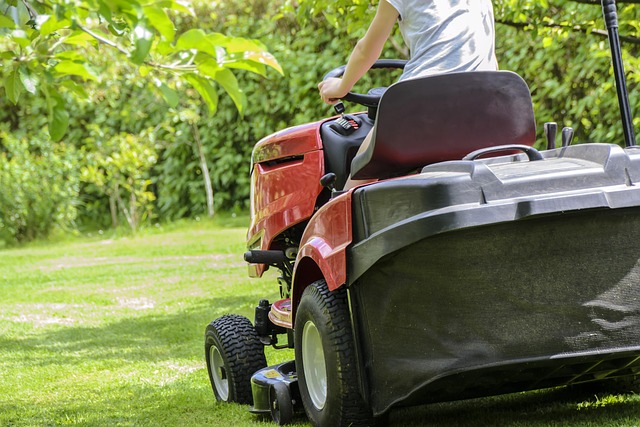Mulching and edging are essential practices in lawn care and landscaping. Mulch conserves moisture, suppresses weeds, enriches soil, and promotes turf health, while edging defines lawn boundaries, prevents weed growth, and enhances curb appeal. Combining these techniques reduces water usage, mowing needs, and encourages root development. Both professionals and DIYers can achieve vibrant, pristine lawns by adopting effective mulching and edging routines.
Transform your lawn into a picture-perfect expanse with the art of mulching and edging. This essential practice in lawn care and landscaping offers numerous benefits, from suppressing weeds to enhancing soil health. Explore different mulching types tailored for various lawn needs. Edging, an often-overlooked technique, adds precision and style to your outdoor space. Discover effective practices to achieve optimal lawn care results, ensuring a lush and well-maintained landscape.
- Understanding Mulching: Benefits and Types for Lawn Health
- The Art of Edging: Enhancing Lawns with Precision and Style
- Effective Mulching and Edging Practices for Optimal Lawn Care
Understanding Mulching: Benefits and Types for Lawn Health

Mulching is a vital aspect of lawn care and landscaping, offering numerous benefits for your lawn’s health and overall appearance. It involves placing organic or inorganic materials on top of the soil to conserve moisture, suppress weeds, and enrich the soil. Organic mulches, such as wood chips, straw, or compost, not only enhance the aesthetic appeal of your garden but also gradually break down, adding essential nutrients to the soil. This natural process improves soil structure, promotes healthy root development, and increases water retention, ensuring your lawn stays lush and green.
Different types of mulches cater to various needs. For example, wood chips provide a long-lasting, attractive option that suppresses weeds effectively. Straw is excellent for temporarily preserving moisture in hot, dry seasons. Composted organic matter is a nutrient-rich choice that improves soil fertility over time. Inorganic mulches like gravel or rock are ideal for dry regions, as they reflect sunlight and reduce water evaporation. Understanding these benefits and selecting the right type of mulch for your lawn care routine can significantly contribute to a thriving, healthy lawn.
The Art of Edging: Enhancing Lawns with Precision and Style

The art of edging is an often-overlooked aspect of lawn care and landscaping that can dramatically transform a property’s exterior. It involves meticulously trimming and defining the edges of your lawn, creating clean lines between grass, flower beds, and walkways. This simple yet precise practice not only gives your yard a polished look but also serves practical purposes. Edging helps prevent weeds from creeping into your lawn and keeps mulch or soil from migrating onto paved areas, maintaining a neat and tidy appearance.
By investing time in this task, you can achieve a sophisticated landscaping design that showcases the beauty of your outdoor space. With the right tools—such as string trimmers, edgers, or hand shears—you can create straight lines, curved edges, or intricate patterns, allowing for both simplicity and creativity. Edging is not just about functionality; it’s an art form that enhances the overall curb appeal and value of your home, making it a must-include step in any comprehensive lawn care and landscaping routine.
Effective Mulching and Edging Practices for Optimal Lawn Care

Effective Mulching and Edging Practices for Optimal Lawn Care
Mulching and edging are essential lawn care and landscaping practices that contribute to a lush, well-maintained garden. Mulch, when properly applied, acts as a protective layer, conserving moisture, suppressing weeds, and gradually releasing nutrients into the soil. This organic matter can come from various sources like wood chips, straw, or compost, each offering unique benefits tailored to different lawn types. Edging, on the other hand, involves defining the boundary between your lawn and paths, gardens, or other landscapes. It not only enhances the aesthetic appeal but also prevents grass from encroaching onto these areas, making maintenance easier.
By combining these two practices, you create a harmonious outdoor space that requires less water, reduces weed growth, and minimizes the need for frequent mowing. Regular mulching helps maintain consistent soil temperature and moisture levels, fostering healthier root development in your lawn. Edging ensures clean lines and a polished look, making your property stand out. Whether you’re a professional landscaper or a DIY enthusiast, incorporating effective mulching and edging practices into your routine is key to achieving and maintaining a vibrant, pristine lawn.
Mulching and edging are essential practices in lawn care and landscaping, offering numerous benefits like weed suppression, moisture retention, and enhanced aesthetics. By understanding different mulching types and mastering the art of precise edging, you can achieve a healthy, well-manicured lawn that stands out in your neighborhood. Incorporating these techniques into your regular maintenance routine will not only save time but also contribute to the overall vibrancy and resilience of your lawn.
